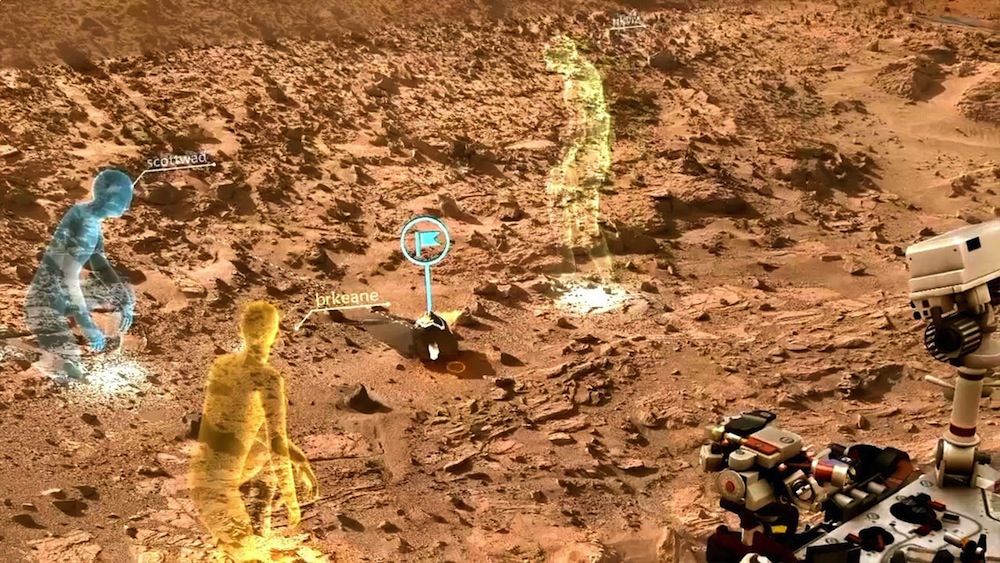
Mars Comes to Earth: Scientists 'Visit' Red Planet with Augmented Reality

WASHINGTON — NASA is aiming to send astronauts to Mars sometime in the 2030s, but a new technology could help scientists explore the surface of the Red Planet — from its sprawling craters to its enormous volcanoes — from right here on Earth.
Researchers at NASA's Jet Propulsion Laboratory (JPL) in Pasadena, California, partnered with Microsoft to develop software that uses the tech giant's HoloLens headsets to allow scientists to virtually explore and conduct scientific research on Mars.
The HoloLens is an augmented reality platform that "allows us to overlay imagery on top of the world and integrate it into that world as I'm looking at it," Tony Valderrama, a software engineer at JPL, said Sunday (April 24) in a demonstration of the technology here at the Smithsonian magazine's "Future Is Here" festival. [Photos: Microsoft's HoloLens Transforms Surroundings with Holographic Tech]
The software, called OnSight, uses real data collected by NASA's Curiosity rover on Mars to create a 3D holographic simulation of the Martian landscape. Scientists wearing the HoloLens headsets can virtually walk around on the Red Planet and interact with the environment.
"We may not be able to actually go to Mars yet, but we can go there virtually," said Parker Abercrombie, a software engineer at JPL who investigates different ways that software can enable augmented exploration.
And because the software was created using actual observations, researchers will be able to conduct valuable science, even while being more than 140 million miles (225 million kilometers) away. For instance, scientists could scale an escarpment to survey the view from that vantage point, or get on their hands and knees for a close-up view of the planet's rocky terrain.
"What's really exciting about this is [that] what we're looking at is a reconstruction of Mars from real data sent from the Curiosity rover," Abercrombie said. "This isn't an artist's conception of what Mars looks like. This is actually what Mars looks like."
Sign up for the Live Science daily newsletter now
Get the world’s most fascinating discoveries delivered straight to your inbox.
Additionally, because Curiosity's mission is ongoing, JPL engineers will be able to make modifications based on the latest data.
"As the rover drives and takes more pictures, our reconstructions are constantly being updated and improved," Abercrombie said.
This holographic technology is also helping NASA build new spacecraft and rovers. At JPL, the HoloLens is being used to design the agency's next Mars rover, which is slated to launch in 2020. By projecting a virtual model of the rover in 3D space, engineers can get close-up views of how the various components fit together, add or move parts around easily, and even walk right through the model to see its inner workings. [Our sister site, Tom's Guide, put together a guide on the best VR headsets on the market right now.]
"It allows us to attain perspectives that are difficult, or even impossible, to attain with a physical model," Valderrama said. "It brings them out into the world so that our engineers can begin to reason and communicate about the models long before any physical artifact exists."
But perhaps the most important advantage of integrating NASA's work with augmented and virtual reality is that it helps make space more accessible to everyone, said Alexander Menzies, software lead for augmented and virtual reality development at NASA.
Now, when the agency sends rovers to the Red Planet — and eventually when human astronauts journey to Mars — technology like the HoloLens and virtual reality headsets will allow people all around the world to come along. These "telenauts," as Menzies dubbed them, will be humanity's virtual explorers of the future.
"A new era of space exploration has begun, and this time, we all get to go," Menzies said. "I look forward to seeing you on Mars."
Follow Denise Chow on Twitter @denisechow. Follow Live Science @livescience, Facebook & Google+. Original article on Live Science.

Denise Chow was the assistant managing editor at Live Science before moving to NBC News as a science reporter, where she focuses on general science and climate change. Before joining the Live Science team in 2013, she spent two years as a staff writer for Space.com, writing about rocket launches and covering NASA's final three space shuttle missions. A Canadian transplant, Denise has a bachelor's degree from the University of Toronto, and a master's degree in journalism from New York University.











